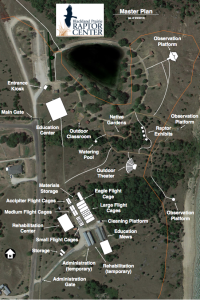|
The Master Plan for Blackland Prairie Raptor Center with four phases of development that include an education facility, interpretive trails through native Blackland Prairie, demonstration gardens with native species, and the creation of a raptor rehabilitation center.
The installation of a Prairie garden is ongoing with the help of local organizations and corporations are partnering on this project including Prairie & Timbers Audubon, Rockwell-Collins, Inc., and Blackland Prairie Chapter of the Texas Master Naturalists. Additional funding
has been provided by a Collin County Open Space grant.

The beginning of Blackland Prairie Raptor Center education caging and offices
Phase One included the education cages and office.
Our FOUNDERS’ CIRCLE page continues to be important to expand the mission of BPRC. Donations at specific levels receive additional benefits. Please call Erich Neupert, Executive Director, with any inquiries, at 469-964-9696.
Building our facility
A facility to provide housing and care for our permanent non-releasable education birds as well as a temporary building for offices and future rehabilitation were Phase One objectives. This was completed in 2009.

Blackland Prairie Raptor Center and the U.S. Army Corps of Engineers are partnering to provide North Central Texas environmental education with an emphasis on birds of prey. The lease of Brockdale Park, 66 acres on the western shore of Lavon Lake near Lucas, provides public use space, native Blackland Prairie, ponds and shoreline to enhance the environmental education activities. Except for individual rentals, the property has been closed to the public for more than 30 years.
BPRCs initial plans involved improvements comprising: the addition of an education facility, building interpretive trails through native Blackland Prairie, installation of demonstration gardens with native species, and the creation of a raptor rehabilitation center.
The first phase of development entailed a facility to provide housing and care for our permanent non-releasable education birds. With this in place, BPRC increased the capabilities to educate the public about the importance of raptors in our North Texas environment.
The second phase focused on education at the existing public use space and permanent trail development, with signage, through Blackland Prairie. The education facility allows BPRC to expand its interpretive capabilities through on site programming for schools and organizations as well as increasing community access to the property for events.
Part of the second phase is the restoration and preservation of Blackland Prairie that sits in the middle of the property. This portion of prairie has not been disturbed in more than 70 years. In 1900, there were more than 16 million acres of Blackland Prairie from San Antonio to the Red River. That total can be counted in thousands of acres in 2008. Blackland Prairie is considered the most endangered large ecosystem in North America according to The Nature Conservancy. BPRC is revitalizing this prairie and creating interpretive trails for the enjoyment and education of the public.
Demonstration gardens in the public use area will exhibit native drought-tolerant species that provide food and shelter for birds, butterflies and excellent examples of xeriscaping. BPRC is working with local environmental organizations including Prairie and Timbers Audubon Society and the Blackland Prairie Master Naturalists to create these gardens to showcase for the public the year round beauty and benefits to landscaping with plant species native to North Texas.
The third phase included a raptor rehabilitation center that was estimated to receive 500 sick, injured and orphaned birds of prey within the first few years of its completion – in its second year, BPRC receive 764 patients! In the long term, plans include handling more than 900 patients a year with numerous intensive care units, a nursery, and an examination/surgical room. Additionally, flight cages necessary for exercise are being built to federal regulations. At this time, there are no facilities in North Texas built to the specifications required for all species of birds of prey found in this area.
|